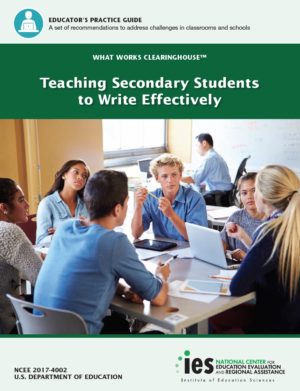Teaching Secondary Students to Write Effectively

The last decade has seen a renewed focus on improving the content writing skills of middle and high school students. A new Educator’s Practice Guide was just published in November, 2016 by the IES (Institute of Education Sciences) titled Teaching Secondary Students to Write Effectively. This report presents writing instruction recommendations aligned with several earlier research reports including Writing Next (2007) and Writing to Read (2010). The authors of the report (Steve Graham and colleagues) organized their recommendations into three sections (see details below).
Similar to reading instruction where the focus after grade 4 shifts from learning to read to reading to learn, the focus for writing instruction also shifts from learning to write to writing to learn. As students move through grades 6 to 12, the need grows to learn to write specifically for different content areas (i.e., disciplinary writing). This opening paragraph from the introduction of the new report sums up the important role of writing:
“Improving students’ writing skills helps them succeed inside and outside the classroom. Effective writing is a vital component of students’ literacy achievement, and writing is a critical communication tool for students to convey thoughts and opinions, describe ideas and events, and analyze information. Indeed, writing is a life-long skill that plays a key role in post-secondary success across academic and vocational disciplines.” (p.1)
Three Recommendations for Teaching High School Students to Write Effectively
Many of the instructional practices that make up our Keys to Content Writing professional development routine incorporate recommendations in the report. I have listed below details from the three recommendations, along with links to free Keys to Literacy resources.
Recommendation 1. Explicitly teach appropriate writing strategies using a Model-Practice-Reflect instructional cycle. Explicitly teach strategies for planning and goal setting, drafting, evaluating, revising, and editing. Instruct students on how to choose and apply strategies appropriate for the audience and purpose. Model strategies for students. Provide students with opportunities to apply and practice modeled strategies. Engage students in evaluating and reflecting upon their own and peers’ writing and use of modeled strategies.
Recommendation 2. Integrate writing and reading to emphasize key writing features. Teach students to understand that both writers and readers use similar strategies, knowledge, and skills to create meaning. Use a variety of written exemplars to highlight key features of texts.
Recommendation 3: Use assessments of students’ writing to inform instruction and feedback. Assess students’ strengths and areas for improvement before teaching a new strategy or skill. Analyze student writing to tailor instruction and target feedback. Regularly monitor students’ progress while teaching writing strategies and skills.
Related Keys to Literacy Free Resources
- Writing process steps
- Student writing assessment checklists and rubrics for teachers
- Self or peer feedback checklist
- List of common transition words
- Teachers’ Writing Assignment Guide to plan writing assignments
Book Chapter:
Training Videos:

 Joan Sedita is the founder of Keys to Literacy and author of the Keys to Literacy professional development programs. She is an experienced educator, nationally recognized speaker and teacher trainer. She has worked for over 35 years in the literacy education field and has presented to thousands of teachers and related professionals at schools, colleges, clinics, and professional conferences.
Joan Sedita is the founder of Keys to Literacy and author of the Keys to Literacy professional development programs. She is an experienced educator, nationally recognized speaker and teacher trainer. She has worked for over 35 years in the literacy education field and has presented to thousands of teachers and related professionals at schools, colleges, clinics, and professional conferences.
Thank you for your recommendations! Writing is really one of the key skills students need to succeed in life. So, of course, we have to pay attention to it.